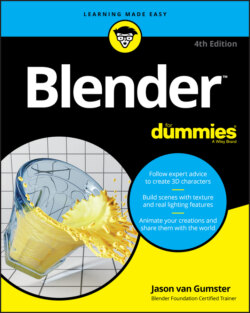Читать книгу Blender For Dummies - Jason van Gumster - Страница 28
MENUS IN BLENDER
ОглавлениеThere’s a somewhat unique quirk of Blender’s menus. Because editors and their headers can literally be just about anywhere in a Blender window, depending on how you’ve split it, menus will either roll down or up from wherever you click, depending on where there’s the most available space. Furthermore, the menus are designed to help you by keeping the distance you need to move your mouse cursor as short as possible. In practice, this means that when you open a menu from an editor’s header near the bottom of the Blender window, it flows upward with the first menu item at the bottom, closest to your mouse cursor. When you open a header menu near the top of the Blender window, it flows downward and the first item is at the top.
For floating menus like the Add (Shift+A) menu in the 3D Viewport (covered in Chapter 4), the behavior is a little bit different. Those menus always list the first item at the top; however, Blender remembers the last item you picked in any of these floating menus and automatically places that item under your mouse cursor. Again, this is for speedy workflow. The idea is that if you chose one menu item last time, it’s likely that you want to pick it again this time. To reduce the distance you have to move the mouse cursor, Blender facilitates this notion by jumping directly to the last menu item you chose.
These are editors you use to make things in a Blender scene:
3D Viewport (Shift+F5): Arguably the most-used editor in Blender, the 3D Viewport shows you the three-dimensional view of your model or scene and provides access to many of the tools you can use to modify it.
Image Editor (Shift+F10): With the Image Editor, you can do basic image editing, masking, and digital painting.
UV Editor (Shift+F10): To apply images to the surface of your 3D objects, you often need to go through a process called unwrapping to edit the texture coordinates for your models (see Chapter 9). The UV Editor gives you the bulk of the tools necessary to complete that process.
Shader Editor (Shift+F3): Blender has a node-based editor for creating and modifying materials and textures. Both Cycles and Eevee, Blender’s two integrated render engines, make heavy use of the Shader Editor for materials and lighting.Chapters 8 to 10 cover materials, textures, and lighting extensively.
Compositor (Shift+F3): Similar to the Shader Editor, Blender uses a node-based system for compositing, or mixing images after they’ve been rendered. To find out all about the Compositor, have a look at Chapter 18.
Texture Node Editor (Shift+F3): The Shader Editor is a great place to generate materials for your 3D objects, but sometimes you need a specific interface for building textures. That’s what the Texture Node Editor is for. Think of it as a Compositor of image data before you render. I get into the Texture Node Editor a little bit in Chapter 9.
Video Sequencer (Shift+F8): Blender’s Video Sequencer is a lightweight video editor. The Video Sequencer isn’t as powerful as some other programs created specifically for editing video, but it’s quite effective for stringing a sequence of scenes together and doing basic effects, overlays, and transitions. See Chapter 17 for more on the Video Sequencer.
Movie Clip Editor (Shift+F2): The Movie Clip Editor is the primary go-to editor for Blender’s motion tracking features. Motion tracking is a process where the software analyzes moving parts of a video in an effort to relate them to 3D space. With video that’s been successfully motion tracked, you can integrate 3D models into recorded video. Have you ever wondered how they get computer-generated monsters to look like they’re in the same room as living actors? Motion tracking! Chapter 19 is all about motion tracking in Blender.
